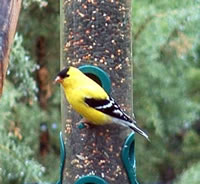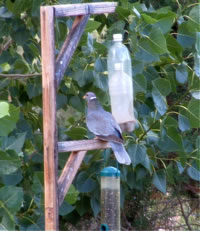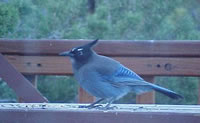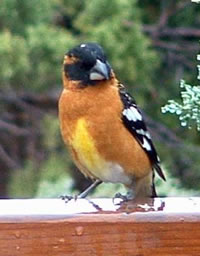 The
question often comes up. Why does the biggest birding event
in the country take place in early winter? Wouldn’t
it make more sense to do it in the spring when the weather
is more cooperative and birds more abundant? Possibly the
more important question is why would any Moabite leave a
warm, snuggly bed to go out on a frosty morning to count
birds? The
question often comes up. Why does the biggest birding event
in the country take place in early winter? Wouldn’t
it make more sense to do it in the spring when the weather
is more cooperative and birds more abundant? Possibly the
more important question is why would any Moabite leave a
warm, snuggly bed to go out on a frosty morning to count
birds?
It’s all about a tradition called the Christmas Bird Count. In
Moab, that tradition has gone on since 1985 when Jeff Connors, who was
the head of Resource Management in Arches, Canyonlands, and Natural Bridges
National Parks teamed up with another local biologist, Nelson Bolschen
who worked for the Utah Division Of Wildlife Resources. They filed the
paperwork with the Audubon Society and set a circle of fifteen miles
in diameter which is divided up into sections with the center at Shrimp
Rock in the Sand Flats Recreation Area. Ranging in elevation from 4,000
to 7,000 feet, it includes Moab, Castle Valley, Spanish Valley, the River
Road (Highway 128), the Matheson Wetlands Preserve, Ken’s Lake
and portions of the La Sal Loop Road.
Between December 14th and January 5th, enthusiastic birders across North
America participate in the oldest and largest wildlife survey in the
world. From dawn to dusk and beyond under the cloak of darkness to listen
for owls, 50,000 vigilant birdwatchers in almost 2,000 counting areas
spend a long, exhilarating day tracking down birds. It even takes place
in the fugid environment of Prudhoe Bay, Alaska, lasting just two and
a half hours with usually only one bird, the raven, on the list.
T his
will be the 105th year for the Christmas Bird Count. Combined with the
Breeding Bird Survey, it gives a clearer picture of how bird populations
have changed since the turn of the 19th century giving a clearer indication
of the increases and declines in bird populations across North America. his
will be the 105th year for the Christmas Bird Count. Combined with the
Breeding Bird Survey, it gives a clearer picture of how bird populations
have changed since the turn of the 19th century giving a clearer indication
of the increases and declines in bird populations across North America.
The date for our local bird count is usually chosen during the November
Moab Bird Club meeting. Then, leaders select their count area and recruit
a team. No matter what the weather, typically 40 to 50 hearty birdwatchers
show up on count day. Approximately 140 miles is covered either by walking
or driving. Every single bird that is seen or heard is counted. Participants
search out neighborhoods with birdfeeders, wetlands, canyons, riparian
areas, the pinyon-juniper habitat and the foothills of the La Sal Mountains.
To understand the origins of the Christmas Bird Count, we have to turn
the calendar back over a hundred years to a holiday tradition that was
called the Christmas Side-Hunt. Back then, on Christmas Day, participants
would choose sides, go afield with guns and whoever slaughtered the most
birds and animals won. As horrifying as it seems now, at that time, all
wildlife was considered an unlimited resource and towards the end of
the nineteenth century, this common attitude had brought many birds to
the brink of extinction. Some like the passenger pigeon and Carolina
parakeet (the only native parakeet in this country) didn’t make
it.
 In
an effort to stop the carnage and educate the public, Frank Chapman,
a famed ornithologist and an early officer in the newly formed Audubon
Society, started the first ever “Christmas Bird Census.” On
Christmas Day, 1900, twenty-seven dedicated birders in twenty-five separate
locations from Toronto, Canada to Pacific Grove, CA went out and counted
all the birds they saw instead of shooting them. Most of the counts took
place in or near the population centers of the northeast. Their list
topped out at ninety species with a total of about 18,500 birds. Now,
the total goes up into the millions. In
an effort to stop the carnage and educate the public, Frank Chapman,
a famed ornithologist and an early officer in the newly formed Audubon
Society, started the first ever “Christmas Bird Census.” On
Christmas Day, 1900, twenty-seven dedicated birders in twenty-five separate
locations from Toronto, Canada to Pacific Grove, CA went out and counted
all the birds they saw instead of shooting them. Most of the counts took
place in or near the population centers of the northeast. Their list
topped out at ninety species with a total of about 18,500 birds. Now,
the total goes up into the millions.
But there’s more than tradition for doing a bird count during the
dark, cold days of early winter when many birds are still in the late
stages of their southward migration. It also opens up the opportumty
to see rare northern birds that have wandered into the Moab area, such
as northern shrike and rough-legged hawk. Usually the bald eagle, rarely
seen in the summer, but a common winter resident along the river corridor,
is added to the list. Other prize winning birds are the merlin (a small
falcon), goshawk, and the tiny saw-whet owl. Sometimes, a peregrine falcon
will pop up adding some extra excitement to the day.
The traditional potluck brunch takes place the following morning. As
the morning progresses, the decibel levels increase with everyone bursting
to talk about birds, birds, and more birds. Rare birds are savored and
bragged about with awe.
 After
the brunch, everyone settles down to listen to the final species total
with the end result usually being around 70. There is a window of three
days after the official count to add on to the list allowing die-hard
individuals to search high and low for those missing birds. After
the brunch, everyone settles down to listen to the final species total
with the end result usually being around 70. There is a window of three
days after the official count to add on to the list allowing die-hard
individuals to search high and low for those missing birds.
Besides good food, camaraderie and a contest, this potluck highlights
the pride of each member of the birdwatching community in the accomplishment
of what they’ve collectively done. Everyone who takes part, including
those counting birds at their backyard feeders, does it for the love
of birds and the excitement offtiendly competition. Knowing what the
Christmas Bird Count has done in the research of bird populations adds
a special significance to a very worthwhile week-end.
Families and beginners are welcome, the more eyeballs the better to point
out the birds. Early winter is a good time to start a lifelong journey
of discovering the mystery and wonder of birds. At that time the numbers
are not so overwhelming and without the dense foliage of deciduous trees
the birds are easier to find. Birds move around, so there are always
some surprises. Often you discover something you didn’t expect,
so if you want to add some extra spice to your holiday season, come on
out and join the fun.
To be a part of the Moab Christmas Bird Count to be held on December
17th, contact Rick Boretti at 259-4050.
|